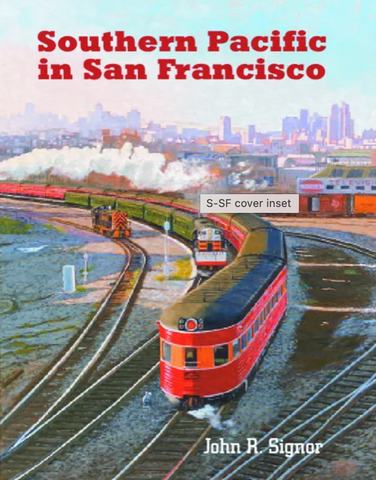SOUTHERN PACIFIC IN SAN FRANCISCO/Signor
IN STOCK AND SHIPPING
While it could be argued that Sacramento, California, was the point from which the vast Southern Pacific Railroad system grew, it was San Francisco that became the nucleus of wealth, power and political influence that was to become the Southern Pacific Co. Here the railroad system was planned, financed and managed. Southern Pacific was one of the first large corporations to make San Francisco its headquarters and was California’s largest employer and land owner for many years – except for the federal government – in most of the states it operated in. Underscoring the city’s importance, San Francisco was milepost zero in a system that identified the location of all points of the vast Southern Pacific Railroad, west of El Paso, by their distance from San Francisco. Within the city itself, SP employed thousands of people over the years in its offices, shops, yards and on its trains, streetcars, ferries and steamships. The railroad gave unselfishly to the relief work that followed the earthquake and fire of 1906. Yet is is in San Francisco that we find the origin of the sobriquet, “the Octopus,” which appeared in editorials criticizing the company’s monopoly of the city’s streetcar systems, long before the popular novel of the same name was published. The opulence of its high-ranking officials added fuel to the fire. San Francisco was the only point on the former Southern Pacific system – or west of the Mississippi, for that matter – that has enjoyed daily commuter rail service for nearly 160 years, mostly under SP management. And it was out of San Francisco that the last of SP mainline steam locomotives operated. Southern Pacific moved into its final decades of activity in San Francisco with a spirit of optimism and innovation. Yet, railroad freight operations eventually withered under intense pressure from other forms of transportation, competition from the Port of Oakland, mergers, and the flight of rail-served industry and warehousing from the city in the face of escalating property values. At this point, Southern Pacific’s greatest asset was the critical real estate it controlled in the city, which it attempted to leverage for much-needed cash. Ultimately by 1996, and the merger with the Union Pacific Railroad, Southern Pacific, had disappeared from San Francisco entirely. This, then, is the story of the rise and fall of this once-great corporation in San Francisco in all of its manifestations spanning 132 years, focusing primarily on its rail operations within the San Francisco Terminal.
List price $80, 344 pages, 8 1/2 x 11 library bound with dust jacket, 560 photos, 33 maps, 21 tables, Bibliography and Index. SKU: BSPSF. Posted May 8, 2023.

